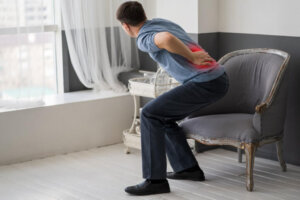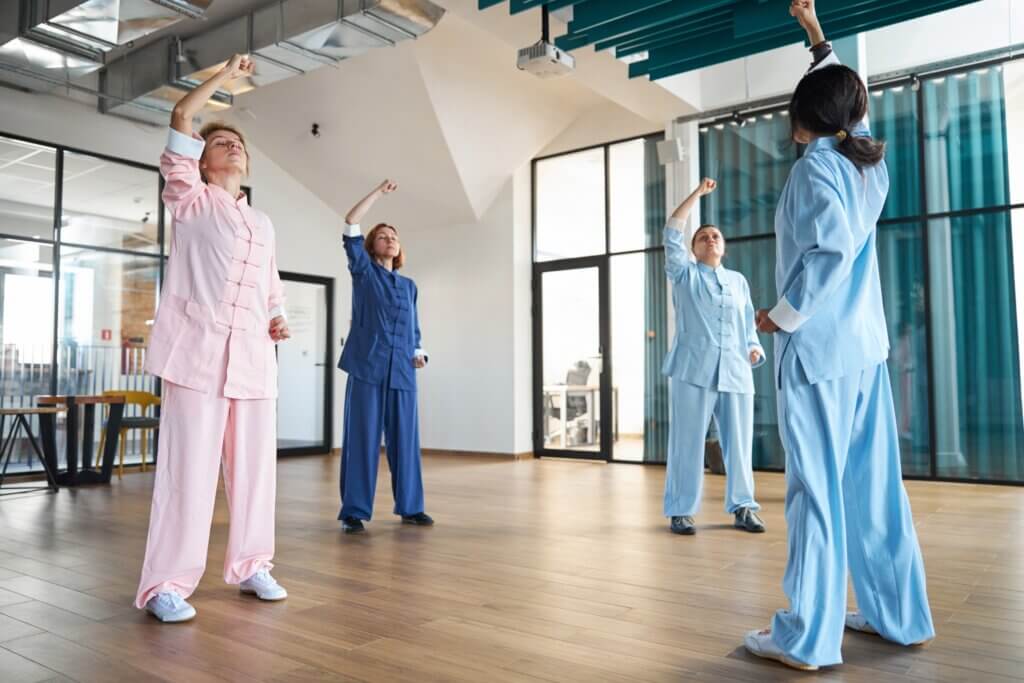7 Tips for Lower Back Pain

Acute lower back pain is one of the most common reasons adults seek medical attention. It’s estimated that up to 7.5% of the population suffers from it, and one in two adults will develop it at least once in their life. Here are some tips for lower back pain so that you can reduce the intensity of the pain and improve your day-to-day well-being.
Episodes of this type are classified into three types: Acute (less than 4 weeks), subacute (less than 12 weeks), and chronic (more than 12 weeks). Despite its high incidence in society, there are many misunderstandings about how to address it among the general public. Today, we’ll dispel some myths and review the most important tips for lower back pain.
7 tips for lower back pain
As the experts remind us, the term lower back pain refers to a range of ailments that are characterized by pain and discomfort below the costal margin and above the lower gluteal folds.
It’s more of a trait or symptom than a condition itself. Many things can cause lower back pain, from lumbar spinal stenosis to disc degeneration to facet joint syndrome.
Our understanding of the causes and characteristics of low back pain has led us to improve treatment alternatives. Many of the things that, until a few decades ago, were considered standard therapy have now been completely relegated. Therefore, we’ll leave you with 7 tips for lower back pain so you can improve your experience from home.
1. Avoid absolute rest
Harvard Health Publishing tells us that while it’s true that bed rest was the mainstay of treatment for back pain in the lower back, today it’s known to do more harm than good.
It’s only recommended in chronic cases, and even so, it’s best to alternate it with activity, even if it’s minor. Complete avoidance of daily activities promotes muscle stiffness, which will only make symptoms worse.
Of course, modifications in the daily routine must be made to balance the activities with the pain. For example, avoid bending over, lifting heavy objects, making sudden movements, and so on.
Movement is very important, and it makes a noticeable difference in the course of symptoms. You can take breaks throughout the day, but avoid absolute rest at all times.
2. Include an exercise program

The consensus among experts is unanimous: Exercise programs are one of the central axes in the treatment of lower back pain. Especially in subacute and chronic cases.
You can choose individual and group sessions, and the range of routines and activities is very wide. Some of the most used are stretching exercises, yoga, tai chi, and hydrotherapy exercises.
The activity can be chosen based on the availability and tastes of each person, although it’s important to vary between the alternatives. The intensity must be regulated to the manifestation of the symptoms.
The regular practice of these and other exercises are also considered a method of prevention. If you’re prone to developing lower back pain, you can include a permanent routine even when you’ve overcome the episode.
3. Practice McKenzie exercises
McKenzie’s exercises are part of the previous program, but due to their impact, they deserve a special section. They were designed by physical therapist Robin Anthony McKenzie in the 1950s and became very popular in the mid-1980s. The exercises are chosen based on a system of prior classification of symptoms.
Thus, the postural syndrome, the dysfunction syndrome, the disorder syndrome, and the non-mechanical syndrome are distinguished. All the exercises revolve around the correction of posture and the implementation of repeated movements carried out under a high frequency.
You can find several routines on YouTube, and as in the previous case, you can use them as a preventive method if you develop lower back pain several times a year.
4. Go to back school
Back school is the name by which a series of educational and training programs are known whose function is to prevent and treat lower back pain.
It consists of teaching the patient the variables that come into play when the pain manifests itself. By being aware of them, you can implement a series of preventive habits to avoid or mitigate it. There’s evidence that patients report an improvement in the short and medium term.
These types of programs are included in what’s known as occupational health. A qualified professional can guide you on what to do and what not to do to keep episodes under control. Understanding the mechanical processes behind lower back pain is very important, especially for patients with chronic pain.
5. Consider relaxation techniques

These methods include progressive muscle relaxation and mindfulness training. The first technique is to focus on a specific group of muscles that are actively relaxing.
Then, alternate between tension and relaxation, until you can do the same in the different muscle groups in the area in which it’s applied. It’s also known as Jacobson’s progressive muscle relaxation.
Mindfulness training consists of a series of habits and exercises that consist of paying more attention to your own thoughts and feelings in the present, as well as understanding and agreeing with them.
All habits are focused on the present and can be combined with yoga and meditation. Both mindfulness and progressive muscle relaxation have been used successfully as pain treatments.
6. Consider biofeedback therapies
Although it hasn’t been considered part of standard therapy for decades, recent evidence indicates that biofeedback therapies may be helpful for lower back pain. This method consists of sensory feedback to allow better control of bodily functions.
In this particular case, it’s used to reduce high muscle activity and to train weak or inhibited muscles in the lower back. There are two types: Biomechanical and physiological. This technique is executed based on visual, auditory, or tactile parameters that allow people to connect them with physical signals that are behind them.
7. Do hot and cold therapies
There’s evidence that hot and cold therapies may be beneficial for people with lower back pain. The benefits are short and medium-term, but it’s less invasive than other types of therapies. Alternate hot and cold compresses, and combine this alternative with the other tips for lower back pain.
Therapy for pain in the lower back is conservative. Acute and subacute cases are approached in the least invasive way possible, and even experts warn against using methods like physiotherapy too soon. Rehabilitation for severe cases is more complex, although all of the above advice for lower back pain can be applied.
Although non-steroidal anti-inflammatory drugs (NSAIDs), skeletal muscle relaxants, and opioids are widely used by patients, the truth is that they must be used with care.
It’s very easy to become dependent on them, as well as exceed the recommended dose. If your pain is very intense and the episodes are recurrent, consult a specialist to design a personalized treatment.
Acute lower back pain is one of the most common reasons adults seek medical attention. It’s estimated that up to 7.5% of the population suffers from it, and one in two adults will develop it at least once in their life. Here are some tips for lower back pain so that you can reduce the intensity of the pain and improve your day-to-day well-being.
Episodes of this type are classified into three types: Acute (less than 4 weeks), subacute (less than 12 weeks), and chronic (more than 12 weeks). Despite its high incidence in society, there are many misunderstandings about how to address it among the general public. Today, we’ll dispel some myths and review the most important tips for lower back pain.
7 tips for lower back pain
As the experts remind us, the term lower back pain refers to a range of ailments that are characterized by pain and discomfort below the costal margin and above the lower gluteal folds.
It’s more of a trait or symptom than a condition itself. Many things can cause lower back pain, from lumbar spinal stenosis to disc degeneration to facet joint syndrome.
Our understanding of the causes and characteristics of low back pain has led us to improve treatment alternatives. Many of the things that, until a few decades ago, were considered standard therapy have now been completely relegated. Therefore, we’ll leave you with 7 tips for lower back pain so you can improve your experience from home.
1. Avoid absolute rest
Harvard Health Publishing tells us that while it’s true that bed rest was the mainstay of treatment for back pain in the lower back, today it’s known to do more harm than good.
It’s only recommended in chronic cases, and even so, it’s best to alternate it with activity, even if it’s minor. Complete avoidance of daily activities promotes muscle stiffness, which will only make symptoms worse.
Of course, modifications in the daily routine must be made to balance the activities with the pain. For example, avoid bending over, lifting heavy objects, making sudden movements, and so on.
Movement is very important, and it makes a noticeable difference in the course of symptoms. You can take breaks throughout the day, but avoid absolute rest at all times.
2. Include an exercise program

The consensus among experts is unanimous: Exercise programs are one of the central axes in the treatment of lower back pain. Especially in subacute and chronic cases.
You can choose individual and group sessions, and the range of routines and activities is very wide. Some of the most used are stretching exercises, yoga, tai chi, and hydrotherapy exercises.
The activity can be chosen based on the availability and tastes of each person, although it’s important to vary between the alternatives. The intensity must be regulated to the manifestation of the symptoms.
The regular practice of these and other exercises are also considered a method of prevention. If you’re prone to developing lower back pain, you can include a permanent routine even when you’ve overcome the episode.
3. Practice McKenzie exercises
McKenzie’s exercises are part of the previous program, but due to their impact, they deserve a special section. They were designed by physical therapist Robin Anthony McKenzie in the 1950s and became very popular in the mid-1980s. The exercises are chosen based on a system of prior classification of symptoms.
Thus, the postural syndrome, the dysfunction syndrome, the disorder syndrome, and the non-mechanical syndrome are distinguished. All the exercises revolve around the correction of posture and the implementation of repeated movements carried out under a high frequency.
You can find several routines on YouTube, and as in the previous case, you can use them as a preventive method if you develop lower back pain several times a year.
4. Go to back school
Back school is the name by which a series of educational and training programs are known whose function is to prevent and treat lower back pain.
It consists of teaching the patient the variables that come into play when the pain manifests itself. By being aware of them, you can implement a series of preventive habits to avoid or mitigate it. There’s evidence that patients report an improvement in the short and medium term.
These types of programs are included in what’s known as occupational health. A qualified professional can guide you on what to do and what not to do to keep episodes under control. Understanding the mechanical processes behind lower back pain is very important, especially for patients with chronic pain.
5. Consider relaxation techniques

These methods include progressive muscle relaxation and mindfulness training. The first technique is to focus on a specific group of muscles that are actively relaxing.
Then, alternate between tension and relaxation, until you can do the same in the different muscle groups in the area in which it’s applied. It’s also known as Jacobson’s progressive muscle relaxation.
Mindfulness training consists of a series of habits and exercises that consist of paying more attention to your own thoughts and feelings in the present, as well as understanding and agreeing with them.
All habits are focused on the present and can be combined with yoga and meditation. Both mindfulness and progressive muscle relaxation have been used successfully as pain treatments.
6. Consider biofeedback therapies
Although it hasn’t been considered part of standard therapy for decades, recent evidence indicates that biofeedback therapies may be helpful for lower back pain. This method consists of sensory feedback to allow better control of bodily functions.
In this particular case, it’s used to reduce high muscle activity and to train weak or inhibited muscles in the lower back. There are two types: Biomechanical and physiological. This technique is executed based on visual, auditory, or tactile parameters that allow people to connect them with physical signals that are behind them.
7. Do hot and cold therapies
There’s evidence that hot and cold therapies may be beneficial for people with lower back pain. The benefits are short and medium-term, but it’s less invasive than other types of therapies. Alternate hot and cold compresses, and combine this alternative with the other tips for lower back pain.
Therapy for pain in the lower back is conservative. Acute and subacute cases are approached in the least invasive way possible, and even experts warn against using methods like physiotherapy too soon. Rehabilitation for severe cases is more complex, although all of the above advice for lower back pain can be applied.
Although non-steroidal anti-inflammatory drugs (NSAIDs), skeletal muscle relaxants, and opioids are widely used by patients, the truth is that they must be used with care.
It’s very easy to become dependent on them, as well as exceed the recommended dose. If your pain is very intense and the episodes are recurrent, consult a specialist to design a personalized treatment.
- Dehghan M, Farahbod F. The efficacy of thermotherapy and cryotherapy on pain relief in patients with acute low back pain, a clinical trial study. J Clin Diagn Res. 2014 Sep;8(9):LC01-4.
- Dunford E, DClinPsy MT. Relaxation and Mindfulness in Pain: A Review. Rev Pain. 2010 Mar;4(1):18-22.
- Eichler J, Rachinger-Adam B, Kraft E, Azad SC. Effektivität von Biofeedback bei Patienten mit chronischem Rückenschmerz : Einfluss auf Schmerz, psychologische Faktoren und Stressmarker [Efficacy of biofeedback in patients with chronic low back pain : Impact on pain intensity, psychological factors and stress markers]. Schmerz. 2019 Dec;33(6):539-548. German.
- Heymans MW, van Tulder MW, Esmail R, Bombardier C, Koes BW. Back schools for non-specific low-back pain. Cochrane Database Syst Rev. 2004 Oct 18;(4):CD000261.
- Linton SJ, Nicholas M, Shaw W. Why wait to address high-risk cases of acute low back pain? A comparison of stepped, stratified, and matched care. Pain. 2018 Dec;159(12):2437-2441.
- Shipton EA. Physical Therapy Approaches in the Treatment of Low Back Pain. Pain Ther. 2018 Dec;7(2):127-137.
- Varrassi G, Moretti B, Pace MC, Evangelista P, Iolascon G. Common Clinical Practice for Low Back Pain Treatment: A Modified Delphi Study. Pain Ther. 2021 Jun;10(1):589-604.
- Wu A, March L, Zheng X, Huang J, Wang X, Zhao J, Blyth FM, Smith E, Buchbinder R, Hoy D. Global low back pain prevalence and years lived with disability from 1990 to 2017: estimates from the Global Burden of Disease Study 2017. Ann Transl Med. 2020 Mar;8(6):299.
Este texto se ofrece únicamente con propósitos informativos y no reemplaza la consulta con un profesional. Ante dudas, consulta a tu especialista.







